Abstract
The early childhood education outcomes according to SDG4 of NGOs on Education 2030 Agenda and United Nations, 2015 targets frame settlement, need to develop professional training for improving educator`s skills and specific competences. Increasing the awareness of attitude and intentional behaviour of preschool teachers on creating and adapting teaching to children`s learning needs will ensure a qualitative and integrative educational environment according to SDG4.as an ecosystem off all global education interested actors have settled realistic targets and objectives to develop global education strategies according to SDG4 (This study reveals the impact of TEACH RO, an observation tool for measuring teacher`s teaching practices including attitudes and predicting intentional behaviour to improve class teaching practices. TEACH RO tool structure for ECEC (early childhood education) conceived on three areas including 29 comportments scale for observation to be applied will provide encoded data for to indicate the real attitudes and intentional perceived behaviour of preschool teachers on promoting qualitative early childhood education.
Keywords: ECEC teaching practices, SDG4, Teach Ro, teachers bahaviour scale observation
Introduction
World Bank during the last years has implemented significantly strategies and made a lot of efforts to build and to sustain the global view of education by improving the outcomes and most to develop the learning context.
The intensive activity has been focused on identifying the most important educational scientific gaps related to topics as: teaching and learning contexts for improving the education systems, the outcomes and the classroom assessment strategies.
Foundational Learning Compact (FLC) which is the World Bank’s fund for education, has become an useful tool in order to influence and to support the global education learning community context, for all together to improve children learning outcomes.
The Compact Learning Foundation Multi-Donor Umbrella Trust Progress Report January 2021 – September 2022 as a progress report (FLC) is one with the most important initiatives on the initiative to create and to implement specific tools for the fundamental improvement of learning in each educational system (The World Bank, 2021).
Teach RO is a tool that describes teaching practices and helps the social and cognitive development of teachers and students and pre-schoolers. This tool supports teachers to diversify teaching and assessment and to emphasize with the need for attention to the three coordinates that aim for the harmonious development of students: Classroom Climate, Instruction and Socio-emotional Skills.
The tool created Teach, released in 2019 is a support tool for teachers to help measuring and evaluating the quality of teaching practices that later to develop children's cognitive acquisitions, development social-emotional skills and to supports learning for all children. Teach Primary and Teach ECE measures classroom teaching practices, supports and ensures achieving quality in teaching activity (The World Bank, 2021).
Teach has already been FLC supports two programs for teachers, Teach and Coach. Both training and coaching programs are meaningful to teachers' classroom practices and effectively contribute to improving children learning outcomes. The main questions formulated of the study research „How can insights from research in other disciplines support teachers’ professional development”, aims to receive and to obtain best teaching and training practices: ”(Bullard & Mijares, 2021).
As part of the technical assistance to support the implementation of the Human Capital Operational Program (POCU, 2014-2020), the World Bank Office in Romania developed a training program for using the Teach tool in classroom observation and improving teaching practices in schools for primary and early childhood level. Teach RO is an observation tool adapted for primary and preschool levels, in accordance with the educational priorities contained in the education reform program, designed on three main areas: classroom climate, instruction and socio-emotional skills.
So, Teach tool applied on ECE (early childhood) area identified strengths and weaknesses from class interactions to establish some activity directions for improving the relevant day by day pedagogical teaching and learning practices. The implementation of Teach in Romania has beginning in 2019 with the teaching practices observation process in sixty classes of primary and preschool education. Based on this preliminary analyses, Teach tool has been adapted to national curriculum and also to the pandemic covid-19 and became Teach RO.
This intervention program results created an innovative training program for primary and preschool teachers designed with synchronous and asynchronous forty hours of activities Teach Ro, version was adapted to the Romanian educational context for classroom observation in primary and preschool education teach în 2021.
Word Bank in partnership with Romanian Educational Ministery has implemented educational policies for reducing early school leaving by improving teachers teaching practices thru Foundational Learning Compact – Teach/Coach Scalling-up National Support for Effcetive Teaching (SUNSET) program, from July 2022 until June 2024 (The World Bank, 2022).
Teach and Coach Tools pilot studies aimed to carry out an impact analysis based on a randomized controlled trial in order to substantiate the intervention and to expand a professional development program for teachers at the national level. The research is represented by a randomized controlled trial research will take place during the 2022-2023 by applying the Tech RO tool in approximately 1000 classes in primary and preschool education for three categories of primary and preschool teachers of the sample as follows: an intervention group that includes teaching staff who benefit from Teach training, a group of teaching staff who benefit from Teach training and Coach support and a control group without intervention.
The training of teachers for the use of the Teach RO Observation Tool is carried out through blended-learning methods of asynchronous training and synchronous training provided by Teach RO through which the training modules that provide learners with working tools and ways to develop effective teaching practices in class and in this case according to the indications of the Observer's Manual.
The design of the Teach Ro Platform facilitates access to the training and training part regarding the formation of skills or specific behaviors of observing the teacher's activity in the classroom through the note-taking stages and the process of coding the observed behaviors. The Teach RO platform offers for systematization and a practical-applicative course questionnaires in the form of evaluations along the way that systematize the understanding and use of Teach RO in the classroom but also offers the development of digital skills, the ability to use new technologies both in professional development and for the realization of the innovative teaching process active-participative.
In some cases observers adjust their ratings and proposed scores based on additional or pre-existing information they have about the teacher, school or children. Or sometimes observers assume certain behaviors by incorrectly inferring the teacher's intentions, and we give another example, "I will give the teacher a score of 5 for a positive environment because even though she was impatient with the student, I know it happens because she had a very busy work schedule". (Teach Ro Observer Manual, version adapted to the educational context in Romania for classroom observation in primary and preschool education teach ro, 2021).
This additional information should not influence the scoring of the targeted behaviors to achieve fair observation and objective assessment as the codes should only reflect what actually happens in the classroom during the allotted 15 minute observation time.
Problem Statement
In accordance with the "Educated Romania" Strategy, every student can fulfil his potential, starting from fair access to a quality education. But for education to be the solid foundation for a democratic and modern society, there must be a coherent vision that brings together solutions to current challenges, as well as a strategy for anticipating and adapting to future demands. There is an urgent need to invest in increasing the quality of education, at the center of which we find teachers and pedagogical practices in the classroom. When teachers excel, teacher effectiveness is perhaps the most important predictor of student learning. Several consecutive years of outstanding teaching can compensate for the learning deficits of disadvantaged students.
According to the analysis of the World Bank Group in 2020 - Human Capital Index (HCI), a child born today in Romania will have a productivity of only 58% when he reaches adulthood, compared to what he could have if he benefited from education and health services of adequate quality. This value is lower compared to the European average and decreasing compared to 2010, when this indicator was 60%.
In Romania, a child can expect to complete 11.8 years of education by the age of 18, compared to a child in France, who can expect to complete 13.8 years. More worrying is the fact that when years of schooling are adjusted for the quality of learning, the World Bank estimates that a child in Romania benefits from only 8.4 years of learning: a learning gap of 3.4 years compared to the period of schooling. Also, those studying in Romania get a score of 442 for learning outcomes on a scale where 625 represents an advanced level and 300 represents a minimum level.
A sustainable investment requires efforts to develop a resilient ecosystem in education. The Human Capital Index draws attention to the fact that Romania must urgently invest in the health and education of its children. We will not be able to accelerate progress without a contribution to increasing quality and without modernizing the educational act in the classroom, so that our students can enter the labor market as skilled and productive adults.
As part of the technical assistance to support the implementation of the Human Capital Operational Program (POCU, 2014-2020), the World Bank Office in Romania developed a training program for using the Teach tool in classroom observation and improving teaching practices in schools. Teach RO is an observation tool adapted for primary and preschool levels, in accordance with the educational priorities contained in the education reform program, targeting three main areas: classroom climate, instruction and socio-emotional skills.
An extended perspective may show that exposing observers to different teaching styles has the potential to influence their objectivity. Another example can be given which is that some observers might think, "When I went to school, this is how I learned" or "My daughter's teacher does this". (Teach Ro Observer Manual, version adapted to the educational context in Romania for classroom observation in primary and preschool education teach ro, 2021).
Within Teach, 3 main areas are observed: Classroom Climate, Instruction and Social-Emotional Skills. These 3 main areas correspond to 9 elements that indicate 28 behaviors. During the observation sessions, these behaviors can be characterized with different qualifiers - "Low", "Medium" or "High".
Teach is a diagnostic system, a monitoring and evaluation tool and an integral part of a teacher professional development program. The Teach tool is useful to all those interested in education, measuring the achievement of standards in the following aspects:
Classroom atmosphere
Teaching activity
Socio-emotional skills
Classroom climate
The content taught
Lesson planning
Teach RO has a classroom observation protocol as follows: classroom observation is done during two 15-minute sessions, with a 10-15 minute break in between, depending on the length of the lesson. Accurately record the duration of the observation, including late starts or early ends. The idea is that if two observers watched the same teacher at the same time, they would come to the same conclusion. For this the manual is followed closely and we have to learn how to code the didactic segments objectively. For objective coding is very important note taking as it provides evidence for the qualifications and scores chosen.
The very important aspects for Teach RO are: the existence of the observer's manual and the observation sheet. Observers must read and use the manual to determine the qualifications and points awarded. At the end of each assisted lesson segment, the observer assigns a grade: "Low", "Medium" or "High", for each behavior included in the Observation Sheet, based on the evidence identified and the descriptions provided by the manual. Scores are assigned for each element according to the overall quality of the behaviors that constitute it. They range from 1 to 5, with 1 being the lowest score and 5 being the highest. The score for an item is determined by comparison with the descriptions in the manual.
To apply the Teach RO tool in a classroom, we must be as objective as possible, for this we must be very attentive to the aspects that can influence us. The idea is that two observers who are both sitting in the same classroom should agree on their scores and how they code what they observe. Our personal experiences and opinions, as observers, of what constitutes good teaching should not influence scoring and coding. Miscellaneous, non-relevant, contextual information should not influence observation scoring, as the codes should only reflect what actually happens in the classroom during the allotted observation time.
When we make several observations in a short period of time there is the possibility that we will be influenced to compare the teaching styles and skills of different teachers. This is precisely why it is very important to follow the manual exactly and observe each segment independently and avoid comparisons with other situations or other teachers.
From classroom experience we are aware that it can seem difficult to make a clear delineation of observed behaviors, because in the classroom all actions are interconnected and sometimes an observed action can serve as evidence for more than one behavior or Teach RO element, but scoring each must be done independently.
Research Questions
This research is focus on using Teach observation tool on preschool level for improving early childhood (ECEC) educators intentional integrative behavior for improving their teaching strategies for applying an integrative approach on class to develop children pre-competences and abilities for learning as well.
This study propose 2 research questions:
How Teach observation tool will improving teachers teaching strategies?
Which are the main aries that will improve most on educators teaching approaches in earlychildhood level (ECEC)?
Purpose of the Study
The training of teachers for the use of the Teach RO Observation Tool is carried out through blended-learning methods of asynchronous training and synchronous training provided by Teach RO through which the training modules that provide learners with working tools and ways to develop effective teaching practices in class and in this case according to the indications of the Observer's Manual.
The design of the Teach Ro Platform facilitates access to the training and training part regarding the formation of skills or specific behaviors of observing the teacher's activity in the classroom through the note-taking stages and the process of coding the observed behaviors. The Teach RO platform offers for systematization and a practical-applicative course questionnaires in the form of evaluations along the way that systematize the understanding and use of Teach RO in the classroom but also offers the development of digital skills, the ability to use new technologies both in professional development and for the realization of the innovative teaching process active-participative.
Research Methods
Continuous training is part of the human resource development process, the most important element in lifelong learning. The realization of a curriculum requires the inclusion and permanent existence of three homogeneously conceived processes, namely design, application/implementation and evaluation. Potolea (2002) claimed that: "the curriculum exists through the three processes, none of them can be suspended and, consequently, they are to be integrated into a comprehensive concept of the curriculum" (p. 81). Therefore, these three processes need to be addressed interdependently. "In the curriculum project, intentions are unified with action, action with evaluation, and evaluation with regulation.
These mutual links, as well as their periodic revision, respectively the periodic revision of the curriculum, are essential in the curricular approach that Bocoș and Chiș (2013) are agree with and reinforce the idea that „he curriculum must be designed in terms of a constantly improved process (and not just the product)" (p. 65).
Bold et al. (2017) assures us that “by emphasizing the professional development of teachers, we can increase the quality of our graduating students. The quality of teachers is the key to student learning" (p. 2).
The method that we used on this research is Teach tool observation scale designed for ECEC early chilhood education as it was conceived by Teach Manual, see Figure 1 (a), (b), (c).
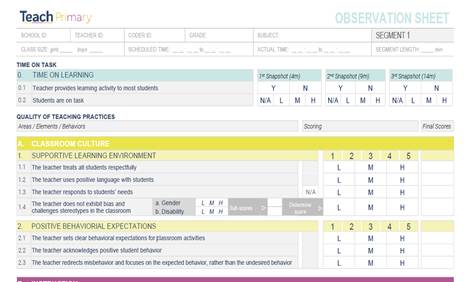
Teach observation tool was used to observe and to notice educators behaviors that were indicated on aries as in the early childhood observation sheet, as showed in Figure 1(a, b, c). We also will observe teaching strategies, lesson designs and teachers behaviours scored along with the early childhood development aries.
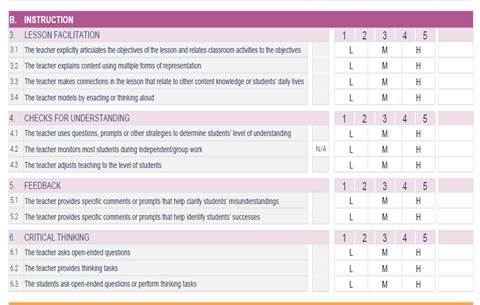
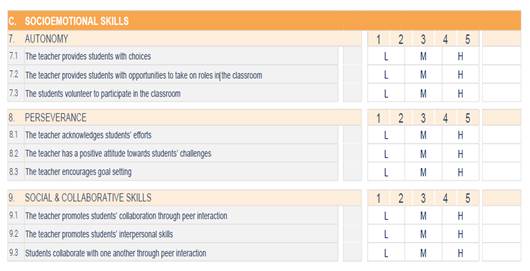
Classroom atmosphere
The quality of teaching practices within TEACH.RO is organized in 3 main areas: Classroom Climate, Training and Socio-Emotional Skills.
Regarding the CLASSROOM CLIMATE, the focus is on the extent to which the teacher creates: 1) an environment conducive to learning by treating all children with respect, consistent use of positive language, responsiveness to children's needs and rejection of stereotypes, as well as the lack of manifestation in class of prejudices related to gender, disability, ethnicity, cultural affiliation, socio-economic status, etc.; and 2) positive behavioral expectations, by setting clear expectations about behavior, publicly acknowledging children's positive behavior, and effectively redirecting the misbehavior.
Teaching activity
Teaching area with the "Comprehension check" component highlights the teacher's activity by checking the level of understanding of the taught content to permanently ensure that most students have understood the lesson content. The teacher thus adapts the pace of teaching to provide students with additional learning opportunities. This aspect will be observed in the classroom, through the following targeted behaviors: C4.1. "The teacher determines the students' level of understanding using questions, helpful suggestions or other verification strategies"; C4.2. "The teacher monitors most of the students during the individual/group activity"; C4.3. "The teacher adapts the teaching to the level of the students".
Teaching area with the "Feedback" component offers ways to observe how the teacher provides feedback in order to deepen the students' understanding by making specific observations or by formulating suggestions that contribute to the identification of ambiguities or the understanding of successes and provides a guide to the processes of children's reflection in order to promote deep learning. This can be observed in the classroom through the following behaviors: C5.1. "Teacher provides specific comments or suggestions to clarify student misunderstandings" and behavior C5.2 "Teacher provides specific comments or suggestions that help students identify their own successes."
"Teaching" area with the "Critical Thinking" component is proposed to observe how the teacher presents the learning content in an attractive way, offering children the environment conducive to the development of critical thinking skills, by forming the skills to express their opinions on learning in a personal and reflective way.
Teaching Area with the specified domains and the described behaviors will be observed and coded according to the Teach RO Observer Manual, measuring the quality of teaching practices in primary and preschool education) by scoring points on a scale from 1 to 5 and representing the quality ranges of the behaviors noted with the following qualifiers: "low", medium" and "high".
Socio-emotional skills-autonomy
Teacher gives children choice and encourages children to participate in class activities. The teacher gives the children the opportunity to choose and take on important roles in the classroom. Children capitalize on these opportunities by volunteering to take on different roles and expressing their ideas and opinions throughout the learning activity. This can be seen by:
Teacher gives the children the opportunity to make choices
Teacher gives the children the opportunity to take on different roles in the classroom
Children volunteer to participate in activities
Teacher highlights children's efforts, rather than emphasizing achievement, intelligence, or innate abilities.
Teacher has a positive attitude towards the problems encountered by the children
Teacher encourages planning in the classroom
Teacher promotes children's collaboration through peer interaction
Teacher promotes children's inter- and intra-personal skills, such as perspective-taking, empathy, emotion management, and social problem-solving skills
Children collaborate with each other through peer interaction
Findings
Range of behaviour Classroom atmosphere
The learning environment refers to a school environment where students feel safe and supported. In addition, all students feel welcome, because the teacher treats everyone with respect. Along with treating students with respect and the use of positive verbal language, the conducive learning environment also includes behavioral elements related to satisfying the needs expressed by children, the manifestation or elimination of prejudices, stereotypes in the relational space of the classroom. (see Figure 2)
Thus, we identify several types of teacher behavior towards children in an attempt to create an environment conducive to learning. Each behavior can be coded with one of the qualifiers - "High", "Medium" or "Low".
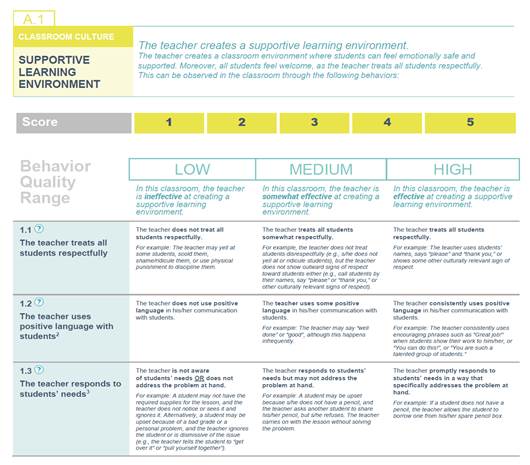
The classroom atmosphere
Range of behavior quality: Teacher treats all children with respect
LOW: Teacher does not treat all children with respect
In this situation, the teacher yells at the children, reprimands them, and ridicules them, may even use corporal punishment or remove them from the class during class.
ENVIRONMENT: The teacher treats all children with some respect
In this case, the teacher does not raise his voice at the students, does not punish them, but also does not call them by name, does not say "please", "thank you" and can even ignore the students.
HIGH: The teacher treats all children with respect
Range of behavior quality: teacher uses positive verbal language with children
LOW: Teacher does not use positive verbal language when communicating with children.
ENVIRONMENT: The teacher uses positive verbal language to some extent when communicating with students. For example: The teacher may say "Well done" or "Good", although this rarely happens.
HIGH: The teacher consistently uses positive verbal language when communicating with students. For example: The teacher constantly uses more or less complex expressions of encouragement regarding results or behavior: "You did very well", "Bravo", "Well done".
Examples of evidence for behavior Teacher uses positive verbal language with the students
▪ "Okay, kids! Very nice! Very good!"
▪ "Whoever knows the multiplication table very well after the holiday will receive a prize."
▪ "You had a wonderful explanation, Maria!"
Range of behavior quality: Teacher responds to the manifest needs of the children
LOW: The teacher does not notice the students' needs OR does not intervene to solve the problem. For example: A student does not have the necessary materials for the lesson and the teacher does not notice this or notices this but ignores it.
ENVIRONMENT: The teacher responds to the students' needs, but does not intervene to solve the problem. For example: A student may be upset because he doesn't have a pencil, and the teacher asks another child to give him the pencil, but he refuses. The teacher continued the lesson without solving the problem. When a student sits alone and angry, the teacher says, “You're angry and you'll do better next time. You practice a little bit at home and you solve the problem, you don't sit around sulking all day."
HIGH: The teacher responds promptly to the needs of the students in a specific way to solve the problem. For example: If a student does not have a pencil, the teacher lends the child a pencil from his spare box. Alternatively, when a student struggles to see the board, the teacher rewrites the larger text or provides the student with an alternative way to access the information on the board, such as on a separate sheet of paper or through oral instruction.
Examples of evidence for behavior Teacher responds to the manifest needs of children
The preschoolers were given the task of making a drawing, but one child did not do the work because he did not have colored pencils, and the teacher did not hear when he asked for help.
During the language education activity, the preschoolers are seated in a semicircle, and the teacher reads a story. During the story a child says he needs the bathroom, the teacher doesn't say anything, just motions him to sit down.
A child does not have the textbook with him, and the teacher lends him his copy.
During the activity, a child tells the teacher that there is too much sun and he does not see what she is showing them. The teacher points to the place where there is a shadow so that he can see better: "Stay a little further back. Look where the blue pillow is."
Range of behaviour Teaching, teaching platform activity
We present the teaching area with the components aimed at "facilitating learning"' checking for understanding', 'feedback' and 'critical thinking'. Specific to this area is the role of the teacher who facilitates the lesson to promote understanding, ensuring good understanding by explicitly formulating the objectives of the lesson, providing clear explanations of the concepts presented and connecting the lesson to other knowledge or experiences of the children to facilitate sustainable learning (see Figure 3).
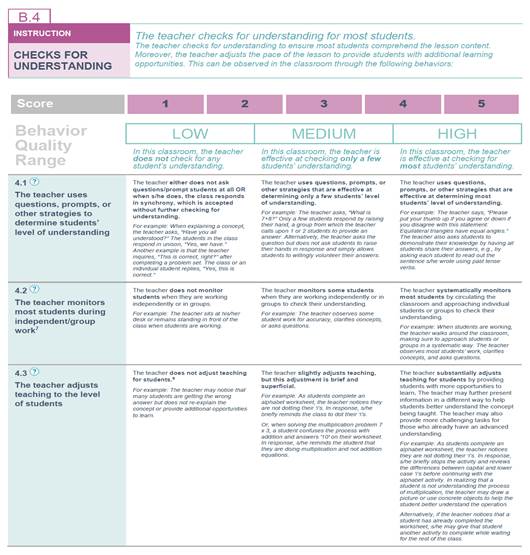
These aspects are observed in the classroom through the following behaviors: C 3.1 "The teacher explicitly formulates the objectives of the lesson and makes the connection between the classroom activities and the objectives"; C3.2. "The teacher explains the content clearly"; C3.3. "During the lesson, the teacher makes connections with other previously acquired knowledge or with the daily life of the students"; C3.4. "The teacher exemplifies or demonstrates through think-alouds or uses multiple forms of representation."
A relevant and notable aspect in the activity of the observer is the fact that exemplification can intervene at any time during the lesson (even at the end). If the learning activity is carried out following a certain procedure, the exemplification will include explaining how the procedure is applied, so students will be able to observe. However, if the purpose of the activity is to develop a thinking skill, we will notice a complete model will include thinking aloud. We can consider an activity to be exemplary if the teacher demonstrates/explains the application of procedures or thought processes related to the learning activity.
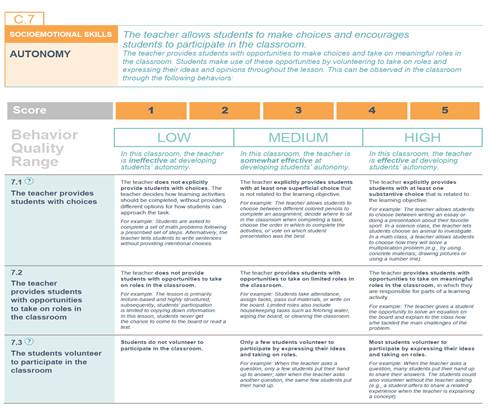
Range of behaviour Teacher gives children the opportunity to make choices
Properly trained teaching staff, using effective techniques and methods for both teaching and learning, manage to stimulate students to learn and develop the ability to work for their personal development (see Figure 4).
The interactions between the teacher and the children, as well as the behaviors shown in the classroom, are elements that an observer analyzes from the perspective of socio-emotional skills, in order to evaluate the students' autonomy, perseverance and collaboration. The measurement of the quality of teaching practices is done using three quality ranges: low, medium and high.
Examples of evidence for behavior Teacher gives children the opportunity to make choices
Low - the teacher fails to develop the children's autonomy. He does not give them the opportunity to choose the activity, the materials or where and how to play or participate in the class activities, he decides how the activities will be carried out, without giving them different options for solving the task. Eg: During the activity of learning natural number order, everyone has to fill in the blanks on a worksheet. No one can solve it otherwise. They are not allowed to participate in any other activity.
Teacher manages to a certain extent to develop the autonomy of the children. The teacher explicitly gives the children the opportunity to make at least one superficial choice unrelated to the learning objective. Eg: During the activity with the children, the teacher allows them to solve the requirement using different colored pens. Children are given the opportunity to solve the requirements standing or using another position, not just the classic one, sitting on a bench.
High - the teacher succeeds in developing the children's autonomy. The teacher explicitly provides children with at least one substantial choice that is related to the learning objective. Eg: In the lesson on ordering natural numbers, children are allowed to order the numbers by completing the worksheet or using balls, sticks. They can play games to sort other children or various objects in the classroom in ascending or descending order by height, they can use apps to order numbers using the calculator or playing cards. Children are given the opportunity to solve the requirement using open-ended choices. E.g.: The teacher asks the children which objects they want to order in ascending order, and the children answer by choosing an application installed on the phone, some pebbles, sticks, balls or other toys of the same shape.
Examples of evidence for behavior Teacher gives children the opportunity to take on different roles in the classroom
Low - the teacher fails to develop the children's autonomy. The teacher does not provide opportunities for children to assume different roles in the classroom. The class is mostly teacher led and very structured. E.g.: Children do not have the opportunity to take on roles in the classroom, erase the board or help their peers understand better. They are only allowed to memorize, they are not given the opportunity to go out on the board or offer help.
Environment - the teacher succeeds to a certain extent in developing the children's autonomy.
Teacher provides opportunities for children to assume limited roles in the classroom. E.g.: In the lesson about plants and their role, students have the opportunity to participate in cleaning activities, distributing teaching materials, they can wipe the blackboard. Roles are limited to administrative ones, supporting the proper running of the class (see Figure 5).
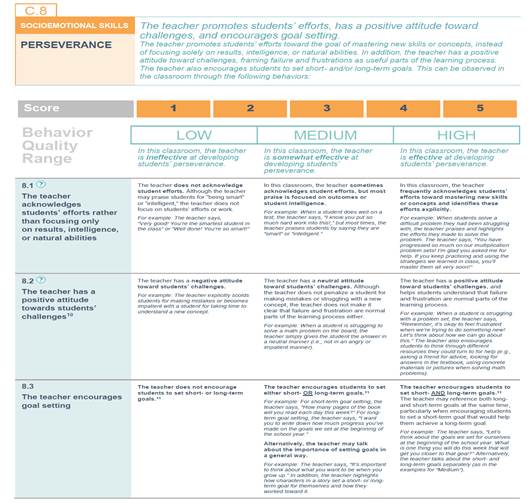
High - the teacher succeeds in developing the children's autonomy. The teacher gives children opportunities to take on important roles in the classroom, being responsible for certain parts of a learning activity. For example: In the lesson about plants and their role, the children have the opportunity to bring plants with roots to class, they can be given the task of presenting the plant they brought from home and help their classmates who do not know what to do to learn better. For example. they can go out into the schoolyard and teach their classmates how to pullout root plants without breaking them, clean them and present them in front of the class. They can be teachers for 5 minutes to teach other children.
Range of behaviour Teacher highlights children's efforts, rather than emphasizing achievement, intelligence, or innate abilities
Examples of evidence for behavior Teacher highlights children's efforts, rather than emphasizing achievement, intelligence, or innate abilities
Low - the teacher fails to develop children's perseverance. The teacher does not recognize the children's efforts. Although the teacher may praise the children by telling them they are "clever" or "intelligent" or by focusing only on the result, the teacher does not emphasize the children's efforts or the process of acquiring new skills. E.g.: The teacher praises the children for being clever, congratulates them on the result of their work, but not on how they got there.
Medium - the teacher succeeds to a certain extent in developing children's perseverance. In this class, the teacher sometimes recognizes the children's efforts, but gives most of the praise in reference to the children's achievements or intelligence. E.g.: The teacher sometimes praises the children for the effort they put in, but most of the time the praise is only for the result achieved by the students, telling them that they are clever or clever.
High - the teacher succeeds in developing children's perseverance. In this classroom, the teacher often recognizes children's efforts, encouraging them to develop new skills or learn new concepts, and explicitly identifies these efforts. E.g.: The teacher congratulates the children for their effort during the learning process to reach the result and publicly recognizes their merits. For example: He tells them "I congratulate you for looking carefully at this plant and recognizing what kind of root it has" or "I like that you formulated the sentence correctly when you answered."
Conclusion
The role of the Teach RO classroom observation tool was to measure the effort in which the teacher facilitates learning by explicitly stating the objectives that correspond to the learning activity, clearly explaining the content and establishing links between the learning activity and other areas of knowledge or aspects related to children's everyday life thus directing the learning activity through acting out or practicing thinking aloud.
Teacher's behavior was constantly check understanding by asking questions in the context of teaching, formulating suggestions or other effective means and strategies in order not to effectively move from one topic to another.
In this way it will determine the level of understanding of the children, by monitoring the children during group or individual learning activities and by adapting the teaching to the level of the children. The teacher will provide permanent feedback by addressing specific comments or indications to clarify children's misunderstandings or to identify their successes.
The valid Teach RO tool adapted to the Romanian education system and the learning needs of teachers represents a tool for diagnosing and developing teaching practices in the classroom, and its application in school practice is an essential step in the process of improving the practices used by teachers from the pre-university education system.
Classroom observation using the Teach RO tool will increase awareness of the role of observation in effective teaching practices and ensure the implementation of beneficial behavior for students and preschoolers that will improve the classroom climate. Teach RO is used as an innovative classroom observation tool that captures the quality of teaching practices with a role in supporting and developing children's socio-emotional and cognitive skills.
References
Bocoș, M., & Chiș, V. (2013). Management curricular (Vol. I). Repere teoretice și applicative [Theoretical and applied milestones] (p. 81). Editura Paralela 45 Pitești.
Bold, T., Filmer, D., Martin, G., Molina, E., Rockmore, C., Stacy, B., Svensson, J., & Wane, W. (2017). What Do Teachers Know and Do? Does It Matter? Evidence from Primary Schools in Africa. DOI: 10.1596/1813-9450-7956
Bullard, K., & Mijares, A. T. D. T. (2021). How can insights from research in other disciplines support teachers’ professional development? Education for Global Development. The Word Bank. https://blogs.worldbank.org/education/how-can-insights-research-other-disciplines-support-teachers-professional-development
The World Bank. (2021). Foundational Learning Compact Umbrella Trust Fund Progress Report. https://thedocs.worldbank.org/en/doc/4dbe8eb0927c7756d593e63afafb71e7-0200022022/related/Final-digital-89095-FLC-TF-Progress-Report.pdf
The World Bank. (2022). Foundational Learning Compact, Teach/Coach Scalinh-up National Support for Effective Teaching (SUNSET). https://www.worldbank.org/en/programs/foundational-learning-compact
Potolea, D. (2002). Conceptualizarea curriculumului. O abordare multidimensională [Curriculum conceptualization. A multidimensional approach]. In E. Păun, & D. Potolea (Eds.), Pedagogie. Fundamente teoretice γi demersuri applicative [Pedagogy. Theoretical foundations and application approaches ] (pp. 82-83). Editura Polirom.
Teach Ro Observer Manual. (2021). Adapted version to the educational context in Romania for classroom observation in primary and preschool education Teach Ro. World Bank Office in Romania, Bucharest. https://documents1.worldbank.org/curated/en/949541542659103528/pdf/Teach-Observer-Manual-First-Edition.pdf
Copyright information

This work is licensed under a Creative Commons Attribution-NonCommercial-NoDerivatives 4.0 International License.
About this article
Publication Date
31 May 2023
Article Doi
eBook ISBN
978-1-80296-962-7
Publisher
European Publisher
Volume
6
Print ISBN (optional)
-
Edition Number
1st Edition
Pages
1-710
Subjects
Education, reflection, development
Cite this article as:
Redeș, D. A., & Roman, A. F. (2023). A Qualitative Research For Improving Preschool Teachers Teaching Practices – Using Teach Ro. In I. Albulescu, & C. Stan (Eds.), Education, Reflection, Development - ERD 2022, vol 6. European Proceedings of Educational Sciences (pp. 660-676). European Publisher. https://doi.org/10.15405/epes.23056.61

